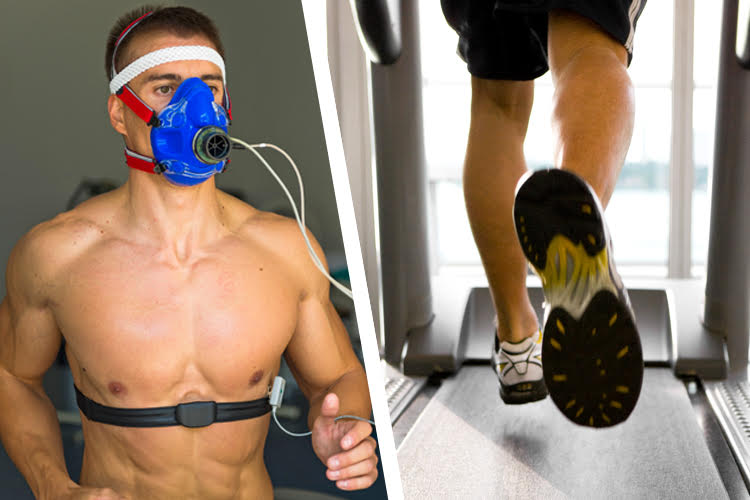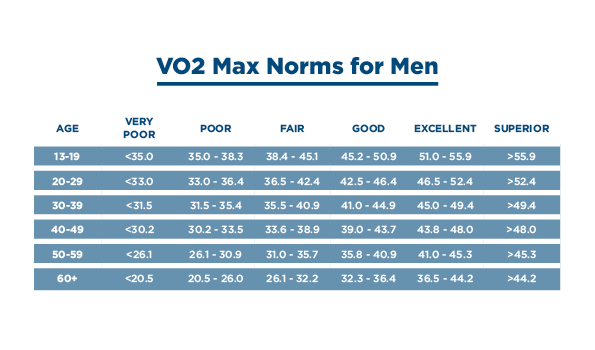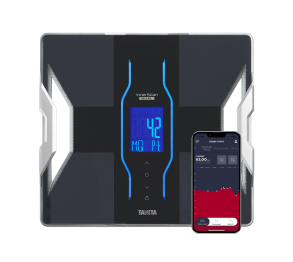Improving your Vo2 Max: definition, tables & norms


When you are training hard and planning your nutrition carefully, you want to see on-going improvements to your fitness. If you want the maximum results for your effort or are pushing your training to a new level, could focussing on your Vo2Max be the secret weapon you need?
What is Vo2 Max?
When you are exercising, your heart and your lungs are working hard to pump oxygenated red blood cells around your body to the muscle tissue, where the oxygen is being used. The more oxygen your body can use, the more your muscles can work.
Vo2 Max is the maximum amount of oxygen your body can use, or maximal oxygen consumption. Improving it will enable you to increase the time you are able to do moderate or high intensity exercise. It should also make that exercise feel easier, and that is likely to make sure you keep doing it!
How is Vo2 Max Calculated?
VO2 max is measured in milliliters of oxygen used in one minute per kilogram of body weight (mL/kg/min). A laboratory measurement of your Vo2 Max will tell you the amount of oxygen your body can use per kilogram per minute. The gruelling test will probably take place in a physiology lab and involves running on a treadmill whilst wearing a breathing mask, with the incline being increased until you reach exhaustion.
Not many of us want to put ourselves through that sort of highly physical test and so you are more likely to be relying on the score given by your tracker or GPS watch, based on your heart rate whilst exercising. Although this is a less accurate score, it can still be a helpful indicator.
What is a good Vo2 Max?
Vo2 Max scores can vary based on a number of factors in addition to fitness, such as your gender, age and genetics, but a vo2 max measurement for an average person in their mid 30s to mid 40s is likely to be around:
- Women – 31 ml oxygen/kg of body weight/minute
- Men - 42 ml oxygen/kg of body weight/minute
This means: an average woman (35-45 years old) consumes about 31 ml of oxygen for every kg that she weighed during each minute of a run. And an average man (35-45 years old) consumes 42 ml of oxygen for every kg he weights during each minute of a run.
For a fit person in the same age range the Vo2 Max is likely to be around:
- Women – 45+ ml oxygen/kg of body weight/minute
- Men – 51+ ml oxygen/kg of body weight/minute
Vo2 max Norms
Using the vo2 max tables for men and women below you can make an estimate of how good your oxygen intake and condition is:
Vo2 Max Table norms for men:


Vo2 Max Table norms for women:


Vo2 max norms for athletes
Athletes record much higher Vo2 Max scores than others. Most female athletes have a score between 60-85 ml and male athletes between 70-85. Some athletes even record a score greater than 90. The highest Vo2 Max scores come from male cross-country skiers, they record values up to 96 ml/kg/min. Female XC skiers record scores in the region 72-80 96 ml/kg/min. Ultramarathon and trailrunners record Vo2 max scores in the region 80-90 ml/kg/min.
What does Vo2 Max mean for runners?
If you have ever wondered why someone of the same age, build and fitness level can run 5k faster than you, it could be down to differences in technique, but they might also have a higher Vo2 Max. If they can get more oxygen to their active muscles, those muscles are going to be able to work harder.
Vo2 Max Improvement
A Vo2 Max improvement will help for many sports and fitness activities, not just those which involve running! Your Vo2 Max should naturally improve as you increase the distance and duration of your training sessions, but here are three additional activities you might want to consider to improve your Vo2 Max:
- Hill reps – hill sessions of 2-3 minutes are a great way to increase your Vo2 Max. Start with 3 – 4 reps and build up to 8 – 10 reps.
- Interval training - Divide a 5k run into between 4 and 8 intervals where you push yourself, so that you are at your max heart rate at the end of the session. Always remember to warm up and cool down properly when you are doing hill reps or interval training!
- HIIT training – a 15–30 second activity at maximum effort, repeated 10–20 times over a number of weeks is a really effective way of building your score. Joe Wicks has a great introduction to HIIT training.
Measuring all the improvements from your hard work
Whilst improving your Vo2 Max is an important consideration if you are looking to improve your speed and endurance, there are no secret weapons in fitness.
At Tanita we want to support you in lifelong fitness rather than just to peak for one race and even if a training session feels really tough, regular use of a body composition scale like the Tanita RD-953 will measure several aspects of your health and fitness, meaning that you can clearly see the impact of all your hard work.
Let us know how you are getting on and also any fitness questions you have which we can address in future blogs.




